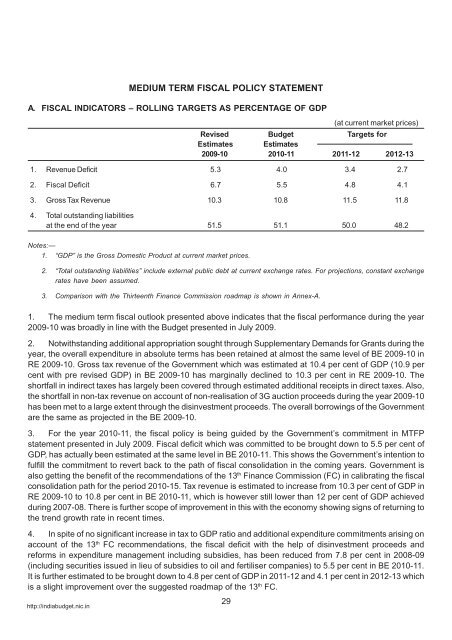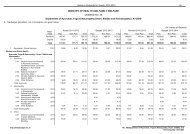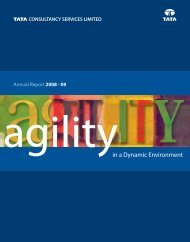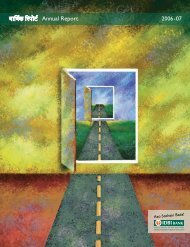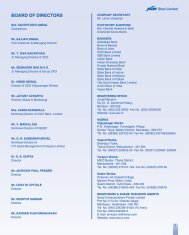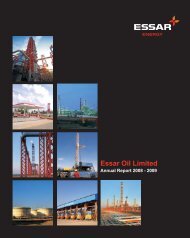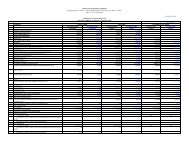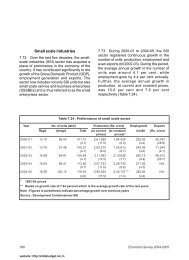Medium Term Fiscal Policy Statement - Union Budget & Economic ...
Medium Term Fiscal Policy Statement - Union Budget & Economic ...
Medium Term Fiscal Policy Statement - Union Budget & Economic ...
Create successful ePaper yourself
Turn your PDF publications into a flip-book with our unique Google optimized e-Paper software.
http://indiabudget.nic.in31during 2010-11, income slabs have been increased for the prevailing tax rate structure and rate of surchargehas been reduced on Corporation Tax. This would help in putting more money in the hands of tax payers andthereby would continue the process of boosting demand. With this tax concession, the BE 2010-11 has beenestimated at Rs.4,30,000 crore for direct taxes reflecting growth of 11.1 per cent over RE 2009-10 andamounting to 6.2 per cent of GDP. This reform is likely to improve compliance and is expected to result inbetter buoyancy in the coming years. For 2011-12 and 2012-13, direct tax receipts as percentage of GDP isprojected to increase from 6.2 per cent in BE 2010-11 to 6.6 per cent and 7.0 per cent respectively. Theseimprovements are associated with projected higher growth in the economy for 2011-12 and 2012-13. Anyslippage in the growth forecast would impact these projections.13. Indirect taxes were estimated at Rs.2,69,477 crore in BE 2009-10. However, with negative growth intrade for the larger part of the financial year and due to impact of lowering of taxes and duties, these areestimated at Rs.2,44,477 crore in RE 2009-10 reflecting negative growth of 9.4 per cent over 2008-09. Howeverthis give away in the form of fiscal stimulus has helped the economy in bouncing back to the higher growthtrajectory. The Government has calibrated the gradual exit strategy to move back to the path of fiscalconsolidation without hurting the revival process. Accordingly, the average rate of Excise Duty is being increasedfrom 8 per cent to 10 per cent. This is still lower than 14 per cent rate which was prevailing before theannouncements of stimulus measures. The intention of the Government is to bring in a uniform tax rate forgoods and services. Without changing the tax rate for Service sector, some more service are being added inthe tax net. Further, in partial rollback of tax measures which were initiated during 2008-09 to protect theeconomy from the adverse impact of higher crude prices, custom duty is being re-imposed on crude andother petroleum products. These additional resource mobilization measures are estimated to yield 0.7 percent of GDP in BE 2010-11. The BE 2010-11 for indirect taxes is Rs.3,15,000 crore reflecting 28.8 per centgrowth over RE 2009-10 amounting to 4.6 per cent of GDP. With the likely introduction of GST from 2011-12,this is further estimated to improve to 4.8 per cent of GDP in 2012-13.14. Based on the above estimates, gross tax to GDP ratio is estimated to improve from 10.8 per cent in BE2010-11 to 11.5 per cent in 2011-12 and 11.8 per cent in 2012-13. This would be still lower than tax to GDPratio of 12 per cent achieved during 2007-08.15. Assignment to States and net Tax Revenue of Centre in BE 2010-11 are placed at Rs.2,08,997 croreand Rs.5,34,094 crore respectively after factoring the recommendations of the 13 th FC.16. The fiscal indicators shown in Table in paragraph A for BE 2010-11 are based on new <strong>Budget</strong> proposals.(b) Non-tax-revenue17. Non-tax revenue (NTR) was estimated at Rs.1,40,279 crore in the BE 2009-10 amounting to 2.3 percent of GDP and reflecting growth of 44.7 per cent over 2008-09 provisional accounts. The increase wasprimarily on account of anticipated receipts of Rs.35,000 crore from the telecommunication sector vide auctionof 3G spectrum and increased transfer of surplus from RBI which was estimated to increase to Rs.25,000crore. However, the receipts from 3G auction have not materialized during 2009-10 and thus there is ashortfall in non-tax revenue in RE 2009-10 which is estimated at Rs.1,12,191 crore. After factoring in receiptsof Rs.35,000 crore from 3G auction now in BE 2010-11, the non-tax revenue is estimated at Rs.1,48,118crore in BE 2010-11 amounting to 2.1 per cent of GDP and reflecting growth of 32 per cent over RE 2009-10.For the period 2011-13, this rate of growth may not be possible in non-tax revenue. Interest receipts fromStates are likely to decline in the medium term, mainly due to Centre’s disengagement from financialintermediation following the recommendation of the Twelfth Finance Commission regarding lending to States,except for loans under externally aided projects. Also the incentive linked restructuring of State Governmentdebt at 7.5 per cent interest will result in downward trend in interest receipts for some more time. Therefore,in the medium term, NTR is expected to marginally improve in absolute terms but will show a progressivelydeclining trend as a proportion of GDP, as the GDP increases. With assumed growth of 7 per cent in NTR, itis estimated to decline to 1.4 per cent of GDP in 2011-12 and 1.3 per cent in 2012-13.(c) Devolution to States18. 13 th FC has recommended for increasing the States’ share in net proceeds of <strong>Union</strong> taxes from thecurrent level of 30.5% to 32% during its award period 2010-2015. It has also recommended increase in theindicative ceiling on total transfers from Centre to the States on the revenue account from 38% to 39.5%. Thiswould impact the availability of resources for the Central Government. For BE 2010-11, additional devolutionof 1.5 per cent to States would result in about Rs.9,800 crore amounting to 0.14 per cent of GDP.
http://indiabudget.nic.in322. Capital receipts(a) Recovery of loans and advances19. Repayment of loans extended to States earlier are estimated to decline over a period of time on accountof (i) gradual disintermediation by Central Government and (ii) the debt consolidation and debt waiver schemebased on the Twelfth Finance Commission (TFC) recommendations. Over time, State Governments andCentral Public Sector Undertakings have been encouraged to borrow directly from the market and not fromthe Central Government. In addition, State Governments were allowed to prepay their high cost loans. Inrespect of Central Government loans, TFC had awarded relief to State Governments in the form of debtconsolidation and waiver subject to enactment of fiscal responsibility legislation and achievement of specifiedtargets relating thereto. However, during the 13 th FC award period, Government would get repayments fromState Governments as the waiver recommended by the 12 th FC would come to an end in 2009-10. Therepayment of loans from Central PSEs is also impacted on account of defaults from PSEs that are either sickor under revival through BIFR. Recovery of loans and advances is estimated at Rs.4,254 crore in RE2009-10 and Rs.5,129 crore in BE 2010-11.(b) Other non-debt capital receipts20. Disinvestment proceeds through sale of Government stake in Central Public Sector Undertakings etc.had been the main source of receipts under this head. In departure from the existing policy of uses ofdisinvestment proceeds, Government has decided to use the disinvestment proceeds received during2009-12 period for the purpose of financing the social sector programmes which are creating capital assets.Disinvestment receipts are estimated at Rs.25,000 crore in RE 2009-10 and Rs.40,000 crore in BE 2010-11.In the future years also, this receipts is estimated at the same level as in BE 2010-11. Also, the returns fromthe investments made earlier through National Investment Fund would continue to be employed to financeselected social sector schemes which promote education, health and employment and to meet capitalinvestment requirement of profitable and revivable CPSEs.(c) Borrowings – Public Debt and Other Liabilities21. The deficit of the Government is financed largely through domestic public debt and to a smaller extentthrough external debt and other internal liabilities or through cash draw down. Government is financing majorpart of its deficit through resources raised at market determined interest rates. For the year 2009-10, theborrowing programme has been completed as per the announced borrowing calendar. The large borrowingduring the year was done without disrupting the market or increasing the yield. In the year, 2010-11 theGovernment would continue to rely on the above mentioned policy of raising resources largely through domesticdebt at market determined interest rates. The net borrowing from the open market in 2010-11 will leaveenough space for the private sector requirements.22. Two other items included in the domestic debt/liabilities of the Central Government are Net accretions toNSSF and Borrowings under Market Stabilization Scheme (MSS). Net accretion to the National Small SavingsFund, to the extent of 80 per cent to 100 per cent is transferred to State Governments as per their option witheffect from 1.4.2007, through investment in State Government special securities issued for the purpose.While accounting for Central Government liabilities, the amount not used for financing Central Governmentdeficit should be taken out for truly depicting Government’s liability. The component of NSSF which are investedas State Governments’ securities may not be taken as GoI liabilities. After factoring in this adjustment, theestimated debt to GDP ratio for Central Government would be 51.5 per cent in RE 2009-10 and 51.1 per centin BE 2010-11 respectively. With the projected level of fiscal deficit of 4.8 per cent of GDP in 2011-12 and 4.1per cent of GDP in 2012-13, the estimated debt to GDP ratio would be 50.0 per cent and 48.2 per centrespectively. These estimates indicate that the Government would be able to bring down the debt to GDP ratiofor Central Government to the recommended level of 45 per cent by the 13 th Finance Commission by2014-15. The details on sources of financing of deficit are shown in the Receipts <strong>Budget</strong>.3. Total expenditure(A) Revenue account(i) Plan Revenue expenditure23. Stepping up of plan expenditure for boosting demand and investment in infrastructure sector were partof the fiscal stimuli provided by the Government to minimise the impact of the global slowdown on the Indianeconomy. Accordingly, plan revenue expenditure has increased from Rs.1,73,572 crore in 2007-08 to
http://indiabudget.nic.in33Rs. 2,34,774 crore in 2008-09 and further to Rs.2,64,411 crore in RE 2009-10. This results in average growthof 23.4 per cent in 2008-09 and 2009-10. Plan revenue expenditure is further estimated at Rs.3,15,125 crorein BE 2010-11 reflecting growth of 19.2 per cent over RE 2009-10.24. With this significant increase in outlay over the last three years, the focus should shift to ensuringeffective implementation and outcomes from financial outlays. The increase in plan expenditure is primarilyaccounted for by higher allocations to the social sector along with urban and rural infrastructure. Notwithstandingdecline in revenue and higher liabilities on specific components of non-plan expenditure including inter alia, formeeting salary commitments, interest obligations, subsidy, defence establishment and capital acquisitions,internal security, pensions, etc., adequate provisions have been ensured for all important developmentalschemes particularly those benefiting the common man and disadvantaged sections of society. While actualexpenditures during the Ninth and Tenth Plan period were only about 84 per cent of projected resources in therespective plan period, it is likely that the overall provision for plan expenditure would be broadly in line with theprojected resources for the Eleventh Plan.(ii) Non Plan Revenue expenditure25. Expenditure on interest payments, defence services, subsidies, salary and pensions and grants toStates constitutes bulk of the non-plan revenue expenditure. These items of expenditure are rigid in natureand likely to remain so in the short to medium term. However, sharp increase in the non-plan expenditurewitnessed during 2008-09 continues in the current financial year also. Non-plan revenue expenditure hasbeen estimated to increase from Rs.6,18,834 crore in BE 2009-10 to Rs.6,41,944 crore in RE 2009-10 reflectinggrowth of 14.8 per cent over non-plan revenue expenditure in 2008-09. Though this growth is lower than whatwas witnessed in 2008-09 (32.8 per cent), it still highlights the concerns on sustainability of the pace of growthof this component of expenditure. This is further estimated to increase from Rs.6,43,599 crore in the BE2010-11 reflecting marginal increase of 0.26 per cent over RE 2009-10. The growth in non-plan revenueexpenditure has plateaued mainly on account of payment of arrears for salary and pension due to theimplementation of the Sixth Central Pay Commission recommendations in 2009-10 and anticipated reductionin subsidy. The major items of non-plan expenditure are detailed below.(a) Interest payments26. Due to the fiscal consolidation in the last four years, interest payments as percentage of total revenuereceipts (net) of the Central Government has shown a significant improvement from 47 per cent in 2003-04 to31.6 per cent in 2007-08. However, due to increased borrowings to finance higher fiscal deficits during2008-09 and 2009-10, this ratio has deteriorated to 38 per cent in RE 2009-10. Interest payments are estimatedat Rs.2,48,664 crore in BE 2010-11 against Rs.2,19,500 crore in RE 2009-10 constituting about 38.6 per centof non-plan revenue expenditure in BE 2010-11. The increase is primarily on account of the higher borrowingsto finance the higher deficit and interest on Special Securities issued to Oil Marketing Companies during2008-09. With the gradual start of fiscal consolidation process in 2010-11, this ratio is estimated to improveto 36.4 per cent in BE 2010-11 and further to 34.6 per cent in 2012-13. For projecting interest payments in2011-12 and 2012-13, incremental debt is assumed at average interest rate of 7.75 per cent. The risk associatedwith the above projections are significant change in interest rate in the coming years or larger than projectedfiscal deficit for the corresponding period. It would be the endeavour of the Government to bring the interestpayment as percentage of total revenue receipts to a sustainable level.(b) Defence Services27. Defence Services expenditure in revenue account is budgeted to increase from Rs.86,879 crore in BE2009-10 to Rs.88,440 crore in RE 2009-10 due to the additional requirements on account of implementationof the Sixth Central Pay Commission recommendations. This is estimated to marginally reduce to Rs.87,344crore in BE 2010-11 on account of payments of salary arrears made in 2009-10. This component of expenditurehas increased from 1.1 per cent of GDP in 2007-08 to 1.4 per cent of GDP in RE 2009-10 due to theimplementation of the recommendations of the Sixth Central Pay Commission. However, with payment ofarrears being taken care of, it is estimated to reduce to 1.3 per cent of GDP in BE 2010-11 and come back tothe level of 1.1 per cent in 2012-13.
36growth rate of 9.2 per cent during 2007-08. The latest release of data from CSO puts the growth rate for2009-10 at 7.2 per cent in real term and after factoring in inflation expectation, the GDP growth (at currentmarket prices) for 2009-10 is estimated at 10.6 per cent. Thus the GDP for the year 2009-10 (at currentmarket prices) is set at Rs.61,64,178 crore. In the year 2010-11, with the assumption that economy will startclimbing back to the trend growth rate, the real GDP growth has been assumed at 8.5 per cent. After factoringin estimated inflation of 4 per cent during 2010-11, the GDP growth (at current market prices) for 2010-11 isestimated at 12.5 per cent resulting in GDP of Rs.69,34,700 crore (at current market prices). For the period2011-12 and 2012-13, the real growth rate is assumed at 8.5 per cent and 9 per cent respectively and afterfactoring in medium term inflation expectation, the GDP growth at current market prices is projected at 13 percent and 13.5 per cent respectively for 2011-12 and 2012-13.C. Assessment of sustainability relating to(i) The balance between Revenue Receipts and Revenue Expenditure43. The task ahead in order to continue the process of fiscal consolidation is admittedly more challenging,especially with regard to the elimination of revenue deficit. The Thirteenth Finance Commission hasrecommended the roadmap for fiscal adjustment and suggested a suitably revised roadmap to maintain thegains of fiscal consolidation through 2010 to 2015, particularly keeping in view the need to bring in the liabilitiesof the Central Government on account of oil, food and fertiliser bonds into the fiscal accounting, and theimpact of various other obligations of the Central Government on the deficit targets. Primarily the fiscalconsolidation during the period 2004-08 was revenue driven, and therefore it has created a stress when therevenue buoyancy fell on account of moderation in economic growth. The focus now has to be on expenditurereform in order to make the fiscal consolidation process sustainable and bring in inter-generational equity infiscal management. This is a major challenge, as many of the components of revenue expenditure are rigid innature and difficult to come down in medium term. At the same time, revenue receipts of the Central Governmentwould be lower on account of higher tax devolution to States. This may be read with the section C on <strong>Policy</strong>Evaluation in the <strong>Fiscal</strong> <strong>Policy</strong> Strategy <strong>Statement</strong>, wherein difficulties in achieving revenue surplus have beenexplained.(ii) The use of capital receipts including market borrowings for generating Productive Assets44. Non-plan expenditure of Rs.7,06,371 crore in RE 2009-10 has exceeded non debt receipts of Rs.6,07,506crore (comprising of Rs.5,77,294 crore of Revenue Receipts and Rs.30,212 crore of non-debt capital receipts).This trend is estimated to continue in BE 2010-11 also. It shows that the Government has to resort to borrowingsfor even meeting non-plan expenditure commitments. This brings us back to the issue of structural problemsin the composition of expenditure which, if not addressed, will further squeeze out the fiscal space for undertakingdevelopmental works. The Government is addressing these issues in right earnest.45. In BE 2010-11 the total Plan expenditure of Rs.3,73,092 crore is about 97.8 per cent of the estimatedfiscal deficit. This was only 81.1 per cent of the estimated fiscal deficit in BE 2009-10. It indicates improvementin deployment of borrowed resources. The Government will make further efforts for not using debt receipts forfinancing non-plan expenditure particularly non-plan revenue expenditure. The endeavour is to bring down theratio of debt to GDP gradually to a sustainable level and use the borrowed funds for creating productiveassets. In the projections for 2011-12 and 2012-13, plan expenditure as percentage of fiscal deficit is furtherestimated to improve to 109.2 per cent and 122.9 per cent respectively.http://indiabudget.nic.in
37Annex - ACOMPARISON OF MTFP WITH 13 th FINANCE COMMISSION FISCAL ROADMAP2010-11 2011-12 2012-13<strong>Fiscal</strong> DeficitMTFP 5.5 4.8 4.113 th FC 5.7 4.8 4.2Revenue Deficit #MTFP 4.0 3.4 2.713 th FC 3.2 2.3 1.2Debt*MTFP 51.1 50.0 48.213 th FC 53.9 52.5 50.5* Excluding NSSF Loans to States and accounting for external debt at current exchange rate.# Difficulties in adhering to the targets for revenue deficit are explained in para 43 above and section C of <strong>Fiscal</strong> <strong>Policy</strong> Strategy <strong>Statement</strong>.http://indiabudget.nic.in


